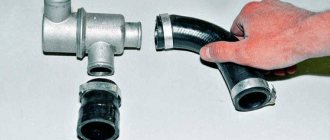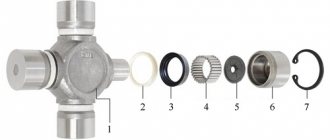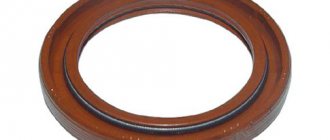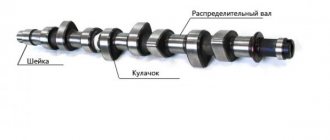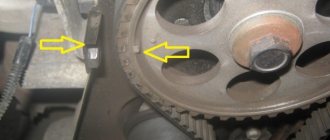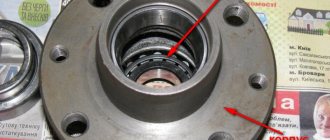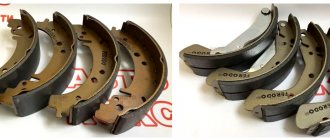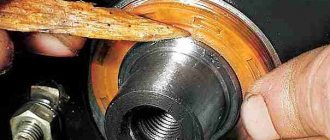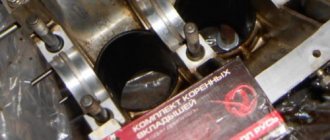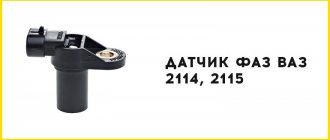01/26/2022 10 401 VAZ 2106
Author: Ivan Baranov
Replacing the camshaft on a VAZ 2106 may be required for various reasons, but before moving on to this process you need to have an idea of the purpose of this unit. The camshaft is the main timing link and participates in the combustion process of the combustible mixture.
The camshaft is located at the top of the cylinder head. It is connected to a pulley or toothed sprocket of the crankshaft via a belt or chain drive.
VAZ 2106 car near a pond [Hide]
Signs of Camshaft Wear
The operation of the camshaft is associated with constant exposure to high loads, as a result of which the part gradually wears out and requires replacement. The need for repair arises when characteristic symptoms appear:
- knocking when the engine is running under load;
- reduction in power indicators.
There are a number of reasons why the RV fails:
- natural wear and tear;
- low-quality motor oil;
- low oil pressure in the lubrication system;
- insufficient oil level or so-called oil starvation;
- engine operation at high temperatures, which leads to deterioration of the lubricant properties;
- mechanical damage (wear or broken chain).
The main malfunctions that impair the performance of the camshaft are scuffing on the working surfaces (journals and cams) and deterioration of the limiter.
Over time, the camshaft's cams and journals wear out.
Knock
It is quite problematic to determine from the sounds coming from the engine compartment that the problem is related specifically to the camshaft, but it is still possible. The knocking sound of the engine resembles the dull blows of a hammer, which become more frequent as the engine speed increases. However, the best way to diagnose a shaft is to dismantle, disassemble and troubleshoot it. During inspection, the shaft should not move in the housing relative to the axis, otherwise a dull sound will be produced when hitting the limiter.
Video: reasons for the longitudinal play of the VAZ camshaft
Power reduction
The drop in power on classic Zhiguli cars is a phenomenon caused by wear of the camshaft and rockers. With proper engine operation (timely oil changes, monitoring its level and pressure), the problem only appears over long vehicle runs. When the cams wear out, the required phase width and valve lift at the intake are no longer ensured.
When the shaft and rockers wear out, the motor power may decrease several times
The RV can become deformed under extreme heat, which is caused by problems in the cooling and lubrication systems. At first, the problem may manifest itself as a knocking sound. Therefore, if there is a suspicion of this breakdown, for example, the motor has overheated, then it is recommended to diagnose the shaft in order to avoid more serious troubles with the engine timing belt.
Installing a new camshaft
In order to install a new timing shaft, you will need the same tools as to dismantle it. The installation procedure is as follows:
- Be sure to lubricate the surfaces of the cams, bearing journals and bearings with engine oil.
- We install the camshaft in the “bed”.
- Using a 10 mm wrench, tighten the bolts of the thrust flange.
- We check how the shaft rotates. It should turn easily around its axis.
- We set the shaft to such a position that its pin would coincide with the hole on the fixing flange.
- We install the bed on the studs, screw on the nuts, and tighten them. It is important to follow the established procedure. The tightening torque is in the range of 18.3–22.6 Nm.
If the camshaft fails
The camshaft on the VAZ 2106 model is rarely dismantled. Typically during repair or disassembly. Sometimes to replace it.
Signs
First, let's talk a little about the signs that indicate that the camshaft is faulty, its journals or beds are worn out. It is difficult to determine whether the shaft or something else is knocking in the VAZ 2106 engine, but it is possible. The knock of the camshaft is dull and clearly audible. As engine speed increases, the knocking becomes more frequent.
Some drivers determine knocking in this unit using a stethoscope or a stick through the valve cover. But often it is difficult for an inexperienced driver to do this. Therefore, the best way to diagnose the camshaft is to remove it, wash it and inspect it.
If the camshaft is faulty, the following symptoms may occur:
- a dull knock, reminiscent of hammer blows;
- it is impossible to adjust the valve clearances; while the crankshaft is turning, the camshaft is constantly in different positions.
This video shows how you can eliminate longitudinal runout of a camshaft.
The most reliable method for diagnosing problems with the VAZ 2106 camshaft is to dismantle it from the car and wash it. You can wash it in gasoline or other cleaning liquid. Next, you need to hold the shaft and hit the bed, when you hear the slightest knock, we determine whether the mechanism is worn out. Be sure to make sure that the shaft does not move in bed, because when it hits the limiter it will make a dull knock.
Removed shaft
The camshaft has a great influence on the pressure in the lubrication system. If the gaps between the bed and the camshaft are large, then the pressure will be low, and as a result, unsatisfactory lubrication of other parts.
Causes
The main malfunctions that result in the need to replace the camshaft are its wear, the appearance of various scuffs and grooves on the bearing journals. Likewise, replacing the camshaft is necessary if it is found to be deformed or cracked. When such malfunctions occur, the power unit loses power and also begins to function intermittently. Problems with the camshaft are identified by a knocking sound in the cylinder head.
The camshaft on the “six” is rarely removed. In addition to the above reasons for replacing and reconfiguring the power unit. After this, you can notice a significant increase in power, like in sports cars.
Checking the condition before starting work
It is faster and more profitable to check the need to replace the shaft on models 2121, 21214 and any other domestic Niva yourself - as well as the installation and dismantling process itself. Moreover, even if the camshaft does not change, it will still have to be removed and repaired (grinded, straightened, balanced). Parts that are severely worn, cracked, or bent must be replaced with a new one.
Preparing for replacement
- wrenches;
- torque wrench;
- chisels;
- socket heads for 10, 13 and 17.
Engine camshaft knocking: causes and troubleshooting
Proper operation of an internal combustion engine is a process that depends on a lot of factors. An important role in it is played by the camshaft, also known as the camshaft. Its task is to control the process of opening and closing the car engine valves, that is, synchronizing the engine cycles.
The camshaft cannot be called a “capricious” engine unit, but it also has its own resource. On different cars, the duration of uninterrupted operation of the camshaft can vary from 50 to 150 thousand kilometers, depending on many facts and the stability of other engine systems.
Leading engine companies claim that in the future it will be possible to dispense with the camshaft in the car. An innovator in this regard is the Swedish company Freevalve, which has been developing an engine without a camshaft for several years now. She plans to abandon the mechanical part in favor of fast electromagnetic actuators, the operation of which will be controlled by a computer.
How to choose quality parts
Buy a camshaft from a reliable and time-tested company, for example, PJSC Avtovaz. The packaging has a seal with a hologram. It shimmers in the light and features the company's logo. There is also a sticker with a barcode on the box. The item is packaged in blue translucent film. There is a stamp from the Quality Control department inside the package. Buy rockers together with adjusting bolts. There are new and old style levers. The holes in them differ in diameter and number of cuts. If you buy rockers and bolts separately, chances are they won't fit together.
The main causes of valve knocking
Smooth engine operation without extraneous sounds often indicates timely and high-quality maintenance, in other words, its serviceability. The appearance of uncharacteristic sounds is the first signal of a malfunction. Unfortunately, the malfunction does not always manifest itself in this way. Valve knocking can be attributed to a problem that can always be determined by ear. A problem like this can signal many future problems.
Risk area
As a rule, problems of this kind occur on an engine with high mileage or a serious problem. In addition, engines that are operated under heavy loads fall into the risk zone; for example, a semi-truck is equipped with an engine that is not designed to transport a load of a certain weight. In addition, valve knocking is a common occurrence on domestically produced cars. However, there are known cases when knocking appears on a cold engine in new foreign cars. What problems can lead to such a phenomenon?
What is the problem?
No matter how far progress has gone in the field of automobile construction, the operating principle of the internal combustion engine has remained virtually unchanged, only improved. Why does valve knocking occur?
What is the cause of valve knocking
Modern vehicles are equipped with a camshaft. It is located on top. The valve is driven by a rod, otherwise called a “Pusher”. The valve makes a tapping sound for some reason. Let's look at each in turn:
1. Almost all motorists know that there is a certain distance between the rod and the valve, which is calculated by vehicle manufacturers. If there is a decrease or increase in space, a loud sound with metal tapping occurs.
2. With constant use of low-quality oil, engine detonation occurs.
3. If there is a knocking sound while driving at high speeds or during acceleration, this may indicate a lack of oil pressure to increase engine power.
4. The timing belt is not installed correctly or is stretched.
5
An important reason is wear and tear. Each part needs to be replaced after some time.
Reasons for installing a split gear
In the opinion of experts, these are the two most significant reasons for installing a split camshaft gear. It should be noted that installing a tuning camshaft without a split gear simply does not make sense. So, the reasons:
- When assembling a standard car engine, the manufacturer allows certain deviations from the drawings. In this regard, the characteristics of engines of one model may differ from the nominal ones with a tolerance of ±10 degrees. This, accordingly, affects the engine power parameters. Installing a split gear allows for adjustment and optimization of torque.
- when installing a sports camshaft, engine power increases, and the use of a split gear, optimizing valve timing, adds 3-5% to the power.
Main reasons
There are several reasons why valves in a car may start knocking. Even a novice motorist must know what affects the incorrect operation of these elements and how to prevent knocking from occurring.
The following reasons for the appearance of knocking can be identified:
- Reducing or increasing the clearances (space) between the valve and the pusher. The gap has a certain value provided by the manufacturer. If it changes, a knocking noise may occur;
- Systematic use of low-quality fuel. Extraneous sound occurs as a result of engine detonation;
- If a knocking noise occurs during acceleration or when driving at high speed, there is likely a lack of pressure in the oil system;
- Stretched timing belt;
- Incorrectly installed timing belt;
- Trivial wear and tear of parts.
But this is general information regarding the occurrence of knocking
Since we are talking specifically about a hot engine, we need to focus on slightly different reasons
There are several factors that cause knocking to occur precisely when the engine is warmed up to operating temperature. It can appear when it is cold and persist when warming up, or it can occur directly when the internal combustion engine reaches a certain temperature.
The reasons are as follows:
- The camshaft bolt that secures it to the so-called bed was not fully tightened. This is a consequence of inattention during repairs, or the bolt simply became loose during the operation of the car;
- There is a shortage of oil in the crankcase. The lack of a sufficient amount of lubricant will certainly result in valves knocking on a hot internal combustion engine;
- The oil filter is dirty and does not fully fulfill its obligations.
In addition to the reasons listed, noise can be a consequence of malfunctioning hydraulic compensators. In some cases, simple adjustments can help get rid of noise. In other situations, complex and expensive repairs will be required.
Valve knocking on a cold engine
When conducting diagnostics, pay close attention to the engine temperature. Some factors may be present regardless of whether the valves are knocking on a hot or cold engine.
Sounds that occur on a cold engine appear for the following reasons:
1. Engine wear.
2. Narrowing of the valves. At a high enough temperature level, all metals have the ability to expand. At minimum everything is different, they decrease. Therefore, the distance from the valve to the pusher decreased, and after the engine warmed up, it reached its original state.
It follows from this that the interval from the valve to the pusher does not correspond to the corresponding standard, and at a high level of engine temperature this may remain undetected.
Camshaft VAZ 2106
The camshaft is an integral part in the design of the gas distribution mechanism (GRM) of any engine. It is made in the form of a cylinder on which necks and cams are located.
Description
On the sixth model Zhiguli, the timing mechanism shaft is installed in the cylinder head (cylinder head) of the engine. This arrangement allows you to repair and change the part, as well as adjust the valve clearances without any difficulties. The shaft is accessible after removing the valve cover. The camshaft (CV) is assigned the role of controlling the opening and closing of valves in the engine cylinders - at the right moment it admits the fuel-air mixture into the cylinder and releases exhaust gases. A gear is installed on the camshaft, which is connected to the crankshaft sprocket through a chain. This design ensures simultaneous rotation of both shafts.
On the camshaft there are cams and journals, by means of which the shaft is held on supports
Since the crankshaft and camshaft have gears of different sizes, the rotation speed of the latter is halved. The full operating cycle in the power unit occurs in one revolution of the camshaft and two revolutions of the crankshaft. The valves in the cylinder head open in a certain order under the influence of the corresponding cams on the pushers, i.e., when the camshaft rotates, the cam presses on the pusher and transmits force to the valve, pressed by the springs. In this case, the valve opens and admits the fuel-air mixture or releases exhaust gases. As the cam rotates further, the valve closes.
The cylinder head consists of the following parts: 1 - cylinder head; 2 — exhaust valve; 3 — oil deflector cap; 4 — valve lever; 5 — camshaft bearing housing; 6 - camshaft; 7 — adjusting bolt; 8—bolt lock nut; A - gap between the lever and the camshaft cam
Options
The “six” camshaft has the following characteristics:
- phase width - 232˚;
- intake valve lift height - 9.5 mm;
- intake valve lag - 40˚;
- exhaust valve advance is 42˚.
On the sixth model Zhiguli, the timing mechanism has eight valves, i.e. two for each cylinder, the number of cams is equal to the number of valves.
Which camshaft is better to install
Only one gas distribution shaft is suitable for the VAZ 2106 - from the Niva. The part is installed in order to increase the power and dynamic performance of the car. It is possible to achieve the desired results, albeit small ones, by increasing the width of the phases and the lift height of the intake valves. After installing the RV from Niva, these parameters will have values of 283˚ and 10.7 mm. Thus, the intake valve will be open for a longer time and raised to a greater height relative to the seat, which will ensure that more fuel enters the cylinders.
When replacing the standard camshaft with a part from a VAZ 21213, the engine parameters will not change dramatically. You can install a “sports” shaft intended for tuning, but it is not cheap - 4-10 thousand rubles.
To improve the dynamic performance of the car, a “sports” camshaft is installed
Table: main parameters of “sports” camshafts for “classics”
| Name | Phase width, o | Valve lift height, mm |
| "Estonian" | 256 | 10,5 |
| "Estonian +" | 289 | 11,2 |
| "Estonian-M" | 256 | 11,33 |
| Shrik-1 | 296 | 11,8 |
| "Shrik-3" | 304 | 12,1 |
Purpose and design of the drive
The gas distribution mechanism is responsible for supplying the fuel mixture to the cylinders and releasing exhaust gases. To ensure timely opening of the intake and exhaust valves, the camshaft must rotate synchronously with the crankshaft. In the Zhiguli, this function is assigned to a chain drive installed in the front of the engine.
Replacing the timing chain and gears cannot be classified as complex operations, but the procedure is quite labor-intensive. To do the work yourself, you need to understand the operating principle and design of the drive, which consists of the following elements:
- a small-diameter drive gear is installed at the front end of the crankshaft;
- above it there is an intermediate large sprocket, which is responsible for rotating the drive of the oil pump and distributor;
- a third driven gear of large diameter is attached to the end of the camshaft;
- The 3 above stars are connected by a double-row chain;
- on one side, the chain is tensioned by a curved shoe, which presses the plunger device;
- to prevent the weakened chain from beating, a second shoe is provided on the other side - the so-called damper;
- A limit pin is installed near the drive sprocket, which prevents the chain from jumping off the teeth.
The main role in the mechanism is played by a double-row chain connecting the lower driving gear with the driven ones.
The required tension of the VAZ 2106 timing drive is provided by a plunger device supporting a semicircular shoe. Older cars were equipped with a purely mechanical plunger - a retractable rod with a powerful spring, which had to be tightened manually. Later models received a hydraulic chain tensioner that operates automatically.
Unknowingly, I once found myself in a stupid situation. A friend’s chain on the “six” was stretched out and began to make a lot of noise, I advised it to be tightened. On site it turned out that the plunger fixing bolt was missing; the advice turned out to be useless. Later it turned out that the car has an automatic tensioner that is activated by oil pressure. The stretched chain had to be replaced.
The timing drive is lubricated by engine oil coming from the camshaft. To prevent lubricant from splashing, the mechanism is hidden behind a sealed aluminum cover, screwed to the end of the cylinder block with 9 M6 bolts. Another 3 screws connect the protective casing to the oil pan.
So, the chain drive performs 3 functions:
- rotates the camshaft, which alternately presses the cams onto the valve stems;
- through a helical gear (in driver's jargon - “pig”) transmits torque to the oil pump;
- rotates the shaft of the main ignition distributor.
The engine smokes
Usually a small amount of smoke comes out of the exhaust pipe. However, sometimes there come moments when thick smoke can literally pour out of your six
To understand what the problem is, you need to pay attention to its color
Transparent color. Transparent or slightly white smoke that is almost invisible. It's not even smoke, but rather steam. It occurs because the system has not yet warmed up. This is especially noticeable in winter after the car has been sitting in the yard all night. There's nothing wrong with that. After the system warms up, the steam will practically disappear. Black color. This phenomenon looks quite scary. One of the reasons may be the usual overload of the motor with heavy weight. Try unloading the trunk if you have placed something particularly heavy in it. However, most often this problem does not arise for VAZ 2106 owners due to the small size of the vehicle
Therefore, also pay attention to how the mixture formation process proceeds. Most likely there is too much fuel entering the engine
The result is not only black smoke, but also increased fuel consumption. Try changing the air filter. You also need to measure the compression. Check the condition of the cylinders and whether the engine control sensors are working correctly. Check the spark plugs to see if they have a black coating on them, which may indicate the need to repair the engine. White color. Unlike the clear smoke described above, this smoke has a thick white tint and does not disappear as the engine warms up. It indicates that there is a malfunction in the cooling system. This is a sure sign that urgent measures need to be taken, because a breakdown can lead to a major overhaul of the engine. Check the candles to see if they have developed a coating similar to what appears on a kettle due to scale. If this happens, it means water is getting into the cylinders. Bluish color. The reasons for this phenomenon can be various breakdowns. For example, you can check the serviceability of the valve stem seals. If they are damaged, oil may leak and enter the idle engine. You will also have to check the oil rings. Due to their wear, excess oil may flow into the cylinders.
Here we have listed only the most common causes of excess smoke. If this information does not help, you need to contact the service center.
Symptoms
To understand that the valves on the VAZ 2110 engine need adjustment, it is enough to know the behavior of the engine
After prolonged use, the car owner may notice that the engine has begun to work somehow differently. This fact should be alarming, because the consequences can be serious.
The main symptoms of a faulty valve mechanism adjustment on a VAZ 2110 look like this:
- the engine is noisy when starting up after a long period of parking (clacks);
- compression in the cylinders disappears (the engine loses its former power);
- Valve cover gasket leaks oil;
- “shots” appeared in the carburetor or muffler;
- fuel consumption has increased.
The listed signs can be diagnosed independently, without resorting to the services of a car service. Before you put the VAZ 2110 in for repairs and begin adjusting the valves, you should prepare a mechanic’s tool: a micrometer, a rack for pressing the pushers and a multi-part feeler gauge. The last thing to measure is the thermal gap between the camshaft cam and the adjusting washer. Instead of a rack, it is possible to use two powerful slotted screwdrivers.
Why are valves knocking? Causes and solutions
The knocking of valves is difficult to confuse with the knocking of the crankshaft, for example, but there are plenty of reasons why valve knocking appears, so a more detailed “inspection” is necessary for a more accurate “conclusion”.
In this article I will try to reveal the problem of valve knocking as much as possible by looking at the causes and ways to eliminate this malfunction.
Most often, valves begin to knock on a car with a considerable mileage, or on someone who, as they say, has “gone in” on his car and doesn’t know what’s in it and where it needs maintenance. Sometimes there are cases when valves knock on completely new cars that are still under warranty. But in this case, the culprit will most likely be some kind of omission.
A little about the camshaft
Fortunately for many, the camshaft is not one of the components that are positioned as capricious, often and quickly failing. The resource largely depends on the quality of the part and operating conditions.
The camshaft has a life limit. Uninterrupted operation can last from 50 to 150 thousand kilometers. These are fairly average indicators, since each situation is still individual. Active work is already underway to remove this element from the engine design. Moreover, experts say that in the future the camshaft may completely cease to be part of the engine. It will be replaced by electromagnetic actuators.
It is difficult to say how effective and realistic this will be in the near future. Plus, some skeptics doubt the correctness of the transition from a mechanical part to a computer-controlled actuator.
Features of the camshaft on a NIVA car
At first glance, the camshaft of a NIVA car is very similar to any other camshaft, however, there are some points by which you can easily determine that this part is specifically for the NIVA.
- Most camshafts have a hex key (usually 27) between the cams of the second cylinder. The camshafts that are manufactured for the NIVA car have two hexagons on their axis (between the cams of the second and third cylinders). Visually, this is the main distinguishing feature of this part.
- The next differentiating factor is the distance between the base and the top of the cam. If you need to make sure that the part is specifically for NIVA, and the presence of a second hexagon does not guarantee the authenticity of the product, pick up a caliper and start measuring. The basic camshaft cam size is the same in most cases and is 30 millimeters. But the distance from the base to the top of the Niva is 37 millimeters. Measuring any other camshaft, the distance will be no more than 36.3 millimeters.
Due to the increased size of the cams, as already described above, the intake phase increases. When compared with other cars, on a NIVA car this phase turns out to be 20 degrees higher (which is also indicated in the passport), this allows you to easily start even at idle.
Removing and installing the camshaft
Removal is most often necessary either during a major overhaul or for replacement in cases of failure. To carry out the work, the following tools are required:
- heads for 10, 13 and 17;
- handle with ratchet;
- knob;
- extension cord with cardan;
- socket wrench 13;
- device for mounting and dismantling the VAZ camshaft.
First, the valve cover is removed, which is bolted to the cylinder head and has a rubber gasket. Try not to damage it, otherwise oil may leak in the future. After this, the timing chain tensioner is unscrewed. It is located on the right side of the engine when viewed from the interior. The camshaft gear is turned by the head to 17.
https://youtube.com/watch?v=CuOAi0WKn-M
For convenience, place the car in gear and place wheel chocks under the rear wheel. Move the gear to the side; if necessary, you can pry it off with a convenient tool. Now all the nuts that secure the camshaft housing must be unscrewed. To make the job easier, use a wrench first.
All threaded connections are tightened with a strong torque, so sometimes it turns out to be difficult to dismantle. Then, slightly rocking the camshaft housing, pull upward with force. And after unscrewing the two nuts in the front of the pencil case, you can easily hit the back of the shaft with a wooden mallet to finally remove it from its seat. The camshaft is installed in the reverse order.
Replacement Guide
The work of removing the crankshaft on a VAZ 2106 is somewhat labor-intensive, but a driver with little experience can do it. We do not need special equipment or special tools to work.
Set of tools
- set of heads;
- ratchet;
- knob;
- extension;
- a set of keys;
- rags.
Wrenches for tightening and loosening bolts
Sequencing
- To get to the crankshaft, you first need to remove the air filter and housing.
- Next, disconnect the choke cable.
- Gas damper drive.
- Clean and wash the valve covers thoroughly. Usually dust and dirt accumulate on it, otherwise they may get inside the motor.
- Now you need to unscrew all the nuts and remove the valve cover. Experts recommend replacing the gasket when removing the valve cover. When purchasing, buy a rubber-cork one, as it holds oil much better than rubber.
- By removing the cover, we gain access to the camshaft; in most cases it is very dirty.
- Now you need to loosen the camshaft sprocket fasteners. To prevent the motor from turning over, insert a screwdriver between the sprocket and the chain.
- Important! Be sure to align the mark on the crankshaft and the camshaft sprocket. You must strive to ensure that the mark on the crankshaft pulley is against the long mark, and the mark on the camshaft sprocket is against the protrusion on the camshaft bed.
- After alignment, we proceed to removing the chain tensioner.
- Unscrew the nuts with a wrench.
- Remove the tensioner.
- We remove the star, which is located on the guide pin.
- After unscrewing the bolt securing the sprocket, remove the sprocket. A hammer may be needed here.
- We tie it to a chain.
- Now you need to unscrew the nuts securing the crankshaft and remove it.
- By the way, it will be noted that if a stud with a nut is turned out, then it is screwed back in with a special stud turner.
- Next, we inspect the camshaft and replace it if necessary.
- The shaft is clamped according to the diagram. The tightening order must be observed. The tightening torque is also important. On a VAZ 2106 car, the tightening torque is 18.3 N/m.
- When assembling, be sure to check that the marks are aligned correctly. If they are out of order, they need to be set correctly.
- Finally, adjust the tension of the chain and valves.
Shaft location under the hood
Air filter housing
Camshaft Alignment of marks on crankshaft Alignment of marks on sprocket
Chain tensioner
Connection of sprocket and chain Removed shaft Scheme for tightening the shaft bolts during installation
If you still have questions and do not understand how the installation is carried out, at what torque the tightening is carried out or how to set the marks, then after reading, watch the video we offer.
Loading …
Knocking in the engine when hot
Calculator for calculating the working volume of an internal combustion engine
Calculator for calculating the cylinder displacement of a car engine
A knocking sound when the engine is hot is almost always a symptom of a serious problem. When the engine is warm, not only hydraulic compensators, unadjusted valves or a timing chain can knock, but also connecting rods, main bearings, or a cracked piston pin, and even a piston that has cracks on its skirt. In any case, it is better to carry out diagnostics not in a garage, but by turning to a car service center for help, since most likely you will need to disassemble the engine.
| Engine operating mode | Causes of knocking |
| Knock at idle |
|
| Knocking noise when under load and increasing rpm |
|
What to do if engine valves are knocking
The easiest and fastest way is to have it repaired by professionals. However, not everyone can afford to pay for their services. Therefore, you have to figure it out and solve the issue yourself. There are motorists who are interested in repairing their car with their own hands. There are also people who accumulate experience in self-repair for some purpose.
If valve knocking is a problem in your car and you have to repair it yourself, be prepared to do some serious work. Seriously and carefully, because if you make a mistake, the sound will only become stronger. Therefore, it is not recommended for a novice motorist to eliminate valve knocking. The sequence of actions is of great importance in this type of repair. First of all, it is recommended to study the repair manual for a specific car brand. Next you need to follow the algorithm:
- Engine oil is drained.
- The cylinder head plug is unscrewed. This will clear the way to the valves.
- The camshaft must be rotated until the mark on the pulley and the unit match.
- Determine the gap between the rods and valves by touch. The size of the gap can be changed using an adjusting washer.
- Depending on the specific car model, you need to turn the washer the required number of revolutions.
- Reassemble everything in reverse order and then check if the valve knocking has gone away.
Each car model has its own operating characteristics. But on average, every 25 thousand kilometers you need to adjust the valve clearances. The number of valves directly affects the noise level when they knock. The more valves, the louder the noise will be in the event of a malfunction. There is an engineering solution to the problem - some cars use hydraulic pushers to accurately maintain valve clearances.
Timing valves require preventive maintenance. It consists of periodically cleaning their surface from the deposits that have formed. Carbon deposits can reach a thickness that makes it difficult for the valves to operate properly. Therefore, you should not forget about their periodic cleaning and grinding. Careful implementation of preventive maintenance will extend the life of the engine and even slightly reduce fuel consumption.
If self-adjustment of the valves does not give a positive result, then it is better to contact a professional service station. Setting the gap yourself in this case is hardly possible. Sometimes the cause of valve knocking is completely different faults. But it is also possible that the valve clearances are set incorrectly.
Why is the camshaft knocking?
The camshaft of a car consists of a number of elements, and the malfunction of most of them leads to the appearance of a characteristic knocking sound during operation of the car engine. If you hear the camshaft knocking, you can assume one of the following reasons:
- Problems with the camshaft bed. In such a situation, independent repair is impossible. It will be necessary to boring or honing the camshaft bed or completely change the part;
- Lubrication system malfunction. Even a small deviation from the norm in the lubrication system can cause the camshaft to start knocking. In this case, the reason may be associated not only with the small amount of incoming oil, but also with its quality. If, as it passes through the units, coolant or other impurities enter the oil, it begins to cope with its tasks worse;
- Deformation of the camshaft or mechanical damage to it (its parts). The most common problems include broken camshaft bearings and broken journals;
- The fuel supply process adjustments are violated;
- The life of the cams has been exhausted. This malfunction can be diagnosed if you are sure that the camshaft is knocking. If it continues to knock while the engine is running hot, then the problem is with worn cams.
The above are just some of the problems that can lead to camshaft knocking. The sooner a specific malfunction is identified using diagnostic equipment or visual inspection by specialists, the greater the chance of eliminating the problem before it begins to affect other elements of the unit.
(410 votes, average: 4.49 out of 5)
When is it time to change the camshaft
Emergency intervention in the operation of the VAZ 2114 8 cl camshaft is necessary in the event of any obvious malfunctions. Signs may be different, for example, a knocking sound is heard when the engine is running or problems with the seals. You need to check what’s wrong in such a situation immediately, either yourself or at a service station.
If you determine that the problem is in the seals, then 10 minutes will be enough for you to make a replacement. The oil seals are located in easily accessible places and installing a new one does not require dismantling large systems and components. If you don’t know which one you need to replace, you can check this simply by looking at which one is already installed.
A more complex malfunction may occur if you hear a knocking sound in the engine. This malfunction may not progress, that is, the knocking does not increase, while the readings of all sensors are normal. Some drivers take this calmly; they are not bothered by this state of affairs and continue to use the vehicle without paying attention to it. But the solution is simple: if your engine knocks, it means that the axial play of the camshaft has increased. In this case, you can put a washer between the camshaft and the cover and there is a high probability that the knocking will stop. A fairly simple way out of this situation.
Some cars are equipped with camshaft position sensors, whose task is to signal in case of malfunction or malfunction of the system. But sometimes sensors fail and may need to be replaced. It is inexpensive and the price of such a sensor on the market does not exceed $10, and you can find out which one to buy from the car’s instructions. Installing such a sensor is simple, so there is no point in stopping there.
How to independently adjust valves on a VAZ 2106
Any mechanism wears out over time and needs debugging. The same can be said about the valves on the VAZ 2106. Initially, their thermal gap is set correctly. However, as the engine operates, its value gradually changes.
Over time, the gap may become smaller or larger. When the clearance decreases, the valves tighten, which leads to a loss of tightness. With large gaps, the valves are not able to open completely.
If there is a problem, you will hear it. The engine will begin to make a characteristic metallic ringing sound coming from the top. People simply say about this unpleasant sound: “valve knocking.” In the video you can clearly hear what it sounds like:
Experts recommend adjusting the valves in a timely manner, without waiting for problems to arise. The VAZ 2106 valves are adjusted after 30,000 kilometers. It wouldn’t hurt to do this after repair work on the engine.
This is especially important to do if the cylinder head has been removed
You can check the gap every 10,000 kilometers.
What are valve clearances for?
In order for the engine to work at its best and develop all its performance characteristics to the maximum, the valves must move clearly and synchronously. The valves should fit tightly into their seats and open to the maximum.
With correctly set valve clearances, a hot engine works almost the same as a cold one, that is, the loss of power is minimal.
When the car is used a lot, for example, working in a taxi around the clock, the valves quickly lose their settings. Many people have probably heard, they say that the valves are knocking. This is just the time to adjust the valves.
Engine camshaft knocking: causes and troubleshooting
Proper operation of an internal combustion engine is a process that depends on a lot of factors. An important role in it is played by the camshaft, also known as the camshaft. Its task is to control the process of opening and closing the car engine valves, that is, synchronizing the engine cycles.
The camshaft cannot be called a “capricious” engine unit, but it also has its own resource. On different cars, the duration of uninterrupted operation of the camshaft can vary from 50 to 150 thousand kilometers, depending on many facts and the stability of other engine systems.
What is a throttle cable
By throttle cable, car enthusiasts understand the throttle cable, which plays an important role in the proper operation of the vehicle. The throttle valve is a structural part of the fuel intake system into an internal combustion engine. Its main function is to regulate the amount of air supplied to the engine for the air-fuel mixture. This damper is located between the air filter and the intake manifold. If the throttle valve opens, the pressure in the intake system is compared to atmospheric pressure. If it is in the closed position, then the pressure drops to vacuum. This action of the throttle valve is necessary to enhance the operation of the vehicle’s braking system and to ventilate the adsorber in the gasoline vapor recovery system.
